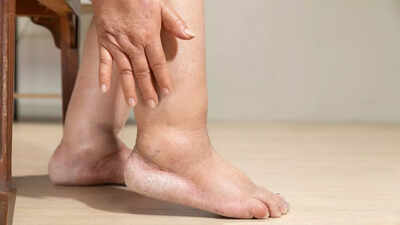Swollen ankles are often overlooked, but they can be an early warning sign of heart failure, a condition where the heart cannot pump blood effectively. One of the most visible symptoms of heart failure is ankle swelling, also known as peripheral edema. This happens when fluid builds up in the lower legs due to poor circulation. Other signs such as shortness of breath, fatigue, and rapid weight gain often follow. Recognising these signs early is key to preventing complications. If you or someone you know is experiencing persistent ankle swelling, it could be a sign of underlying cardiovascular issues.
Recognising heart failure through swelling in ankles: Key signs to watch for
Heart failure happens when the heart becomes too weak or stiff to pump blood efficiently. It does not mean the heart has stopped, but rather that it is not working as well as it should. As a result, blood backs up, and fluid can build up in the body, especially in the lower extremities.Ankle swelling occurs when fluid leaks from blood vessels into nearby tissues. This is often caused by:
- Poor circulation due to a weakened heart
- Increased pressure in the blood vessels
- Fluid retention by the kidneys
- Hormonal changes affecting blood volume
- Because gravity pulls fluid downward, swelling is most noticeable in the feet, ankles, and legs.
These signs may indicate heart-related swelling:
- Both ankles appear puffy or enlarged
- Skin feels tight and leaves an indent when pressed
- Socks or shoes feel tighter than usual
- Swelling worsens by evening or after standing for long periods
Swelling that affects both ankles equally is more likely linked to heart failure. If only one side is swollen, other causes like injury or a blood clot may be involved.
Other symptoms of heart failure
In addition to ankle swelling, people with heart failure may also experience:
- Shortness of breath, especially when lying down or during physical activity
- Extreme tiredness or weakness
- A fast or irregular heartbeat
- Rapid, unexplained weight gain
- Frequent urination at night
- Coughing or wheezing that does not go away
These symptoms can develop slowly over time or appear suddenly.
How is it diagnosed
If you notice swollen ankles along with any of the symptoms above, your doctor may recommend tests such as:
- Physical examination and medical history
- Blood tests to check for signs of heart stress (such as BNP levels)
- Chest X-ray to detect fluid in the lungs
- Echocardiogram to examine heart structure and function
- Electrocardiogram (ECG) to assess heart rhythm
These tests help confirm whether heart failure is the cause of swelling.
Treatment options for swelling from heart failure
Treatment focuses on improving heart function and reducing fluid buildup. Common approaches include:1. MedicationsAs advised by your healthcare provider2. Lifestyle changes:
- Reducing salt intake to prevent water retention and bloating
- Elevating your legs while resting to reduce swelling and discomfort
- Daily weight monitoring to detect fluid changes and alert healthcare providers
- Wearing compression stockings if advised by a doctor for added support
- Engaging in gentle physical activity to support circulation and overall health
When to seek medical help
It is important to contact your doctor if you:
- Notice new or worsening swelling in your ankles or legs
- Feel short of breath even at rest
- Gain more than 2 kilograms (about 5 pounds) in a few days
- Experience chest pain, light-headedness, or fainting
These symptoms may signal worsening heart function and require immediate attention.Also read | What’s causing your headaches? 10 common triggers you didn’t know about






